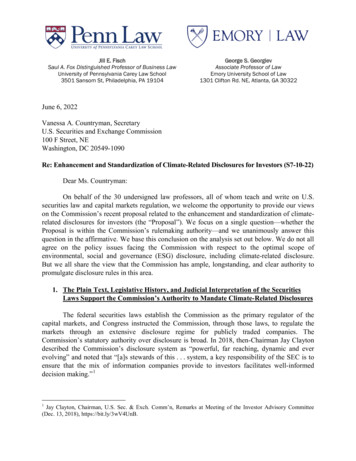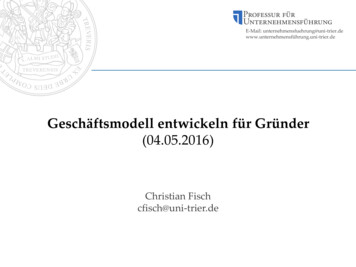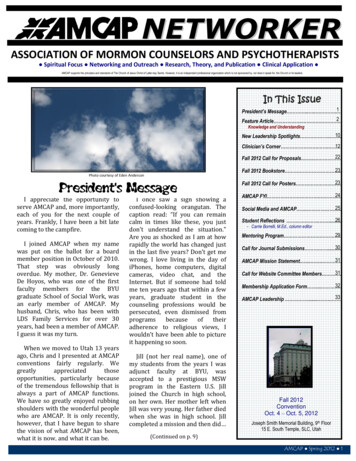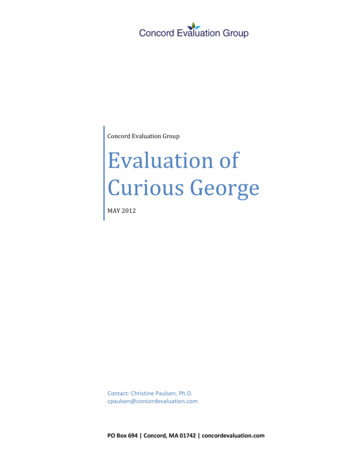
Transcription
Jill E. FischSaul A. Fox Distinguished Professor of Business LawUniversity of Pennsylvania Carey Law School3501 Sansom St, Philadelphia, PA 19104George S. GeorgievAssociate Professor of LawEmory University School of Law1301 Clifton Rd. NE, Atlanta, GA 30322June 6, 2022Vanessa A. Countryman, SecretaryU.S. Securities and Exchange Commission100 F Street, NEWashington, DC 20549-1090Re: Enhancement and Standardization of Climate-Related Disclosures for Investors (S7-10-22)Dear Ms. Countryman:On behalf of the 30 undersigned law professors, all of whom teach and write on U.S.securities law and capital markets regulation, we welcome the opportunity to provide our viewson the Commission’s recent proposal related to the enhancement and standardization of climaterelated disclosures for investors (the “Proposal”). We focus on a single question—whether theProposal is within the Commission’s rulemaking authority—and we unanimously answer thisquestion in the affirmative. We base this conclusion on the analysis set out below. We do not allagree on the policy issues facing the Commission with respect to the optimal scope ofenvironmental, social and governance (ESG) disclosure, including climate-related disclosure.But we all share the view that the Commission has ample, longstanding, and clear authority topromulgate disclosure rules in this area.1. The Plain Text, Legislative History, and Judicial Interpretation of the SecuritiesLaws Support the Commission’s Authority to Mandate Climate-Related DisclosuresThe federal securities laws establish the Commission as the primary regulator of thecapital markets, and Congress instructed the Commission, through those laws, to regulate themarkets through an extensive disclosure regime for publicly traded companies. TheCommission’s statutory authority over disclosure is broad. In 2018, then-Chairman Jay Claytondescribed the Commission’s disclosure system as “powerful, far reaching, dynamic and everevolving” and noted that “[a]s stewards of this . . . system, a key responsibility of the SEC is toensure that the mix of information companies provide to investors facilitates well-informeddecision making.” 11Jay Clayton, Chairman, U.S. Sec. & Exch. Comm’n, Remarks at Meeting of the Investor Advisory Committee(Dec. 13, 2018), https://bit.ly/3wV4UnB.
Congress, in the original federal securities laws, the Securities Act of 1933 and theSecurities Exchange Act of 1934, authorized the Commission to promulgate rules for registrantdisclosure pursuant to broadly articulated delegations of authority. For example, Section 7 of theSecurities Act identified categories of information required to be included in the registrationstatement for public offerings, as augmented by “such other information . . . as the Commissionmay by rules or regulation require as being necessary or appropriate in the public interest or forthe protection of investors.” 2 Section 12 of the Exchange Act conditions trading on exchanges ondisclosing “such information, in such detail, as to the [company] . . . as the Commission may byrules and regulations require, as necessary or appropriate in the public interest or for theprotection of investors, in respect of the following: . . . the organization, financial structure, andnature of the business.” 3 Section 13(a)(2) of the Exchange Act, which establishes the periodicreporting framework for public companies, requires companies to disclose information underrules the Commission “may prescribe as necessary or appropriate for the proper protection ofinvestors and to insure fair dealing in the security . . . such annual reports . . . and such quarterlyreports . . . as the Commission may prescribe.” 4 Section 3(b) of the Exchange Act addsCommission authority to “define technical, trade, accounting, and other terms used [in thestatute].” 5 These are only some examples of Congress’ broad delegation to the Commission ofthe power to determine what disclosure is necessary or appropriate in the public interest, or forthe protection of investors, or to promote fair dealing in securities traded on the U.S. capitalmarkets. 6Moreover, Congress recognized that capital market regulation was essential, not just forinvestor protection, but to serve the broader interests of the U.S. economy. As a result, in 1996,Congress instructed the Commission in determining whether a disclosure requirement isnecessary or appropriate to consider “whether the action will promote efficiency, competition,and capital formation.” 7 This language reflects well-settled understanding that public companysecurities trade in efficient markets and that the prices of those securities incorporate relevantand accurate information generated through the Commission’s disclosure requirements andguaranteed through its liability regime. This regulatory scheme serves to protect investors,improve market efficiency, and ensure the productive allocation of capital.We further note that the Commission’s disclosure authority extends not just toinformation relevant to investor trading decisions but also to information used by investors inconnection with the exercise of their voting power. The Commission’s broad authority toregulate the proxy voting process, found in Section 14(a) of the Exchange Act, requires proxy2Securities Act of 1933, 15 U.S.C. §77g, § 7(a)(1).3Securities Exchange Act of 1934, 15 U.S.C. § 78l, § 12.4Securities Exchange Act of 1934, 15 U.S. C. § 78m(a)(1), § 13(a)(1).5Securities Exchange Act of 1934, 15 U.S. C. § 78c(b).6See also Sections 10 and 19(a) of the Securities Act; Sections 14, 15(d), and 23(a) of the Exchange Act. We notefurther that the Commission has established a related disclosure regime for investment funds and advisers pursuantto the Investment Company Act of 1940, 15 U.S.C. § 80a-1 et seq., and the Investment Advisers Act of 1940, 15U.S.C. § 80b-1, et seq.7Securities Act § 2(b); Exchange Act § 23(a)(2). Congress added a similar provision to the Investment CompanyAct of 1940 in 1999. 15 U.S.C. § 80a–2(c).2
solicitations to be conducted in accordance with “such rules and regulations as the Commissionmay prescribe as necessary or appropriate in the public interest or for the protection ofinvestors.” 8 Shareholder voting on issues ranging from the election of directors to the approvalof mergers is a critical governance tool, and the Commission’s disclosure requirements enableshareholders to exercise that voting power on an informed basis.Courts have always interpreted the authorization to act as “necessary or appropriate in thepublic interest or for the protection of investors” as granting the Commission broad rulemakingauthority. As summarized by the D.C. Circuit Court of Appeals in 1979, “the Commission hasbeen vested by Congress with broad discretionary powers to promulgate (or not to promulgate)rules requiring disclosure of information beyond that specifically required by statute.” 9 We notethat no court has invalidated a Commission rule for overstepping the Commission’s disclosureauthority despite the Commission’s active rulemaking spanning close to nine decades and despitethe fact that, as is often the case with economic regulation, many of the Commission’s rules wereinitially resisted by the regulated entities and other interested parties.Even a narrow reading of the legislative history of the original securities laws supportsthe Commission’s authority to pursue the Proposal because climate-related matters impact themost important aspect of any securities transaction—the price at which investors buy or sell—and Congress was focused on valuation matters, among others, when it adopted the SecuritiesAct in 1933. Congress’ intent was to create an information-generating regime “designed to reachitems of distribution profits, watered values, and hidden interests . . . [of] indispensableimportance in appraising the soundness of a security,” which contains “items indispensable toany accurate judgment upon the value of the security.” 10It is important to consider the Proposal within the established legal context describedabove. The Commission’s proposal requires that issuers disclose climate-related informationrelevant to their business operations. This information includes, inter alia, qualitative disclosuresabout the issuer’s climate-related governance, risks and strategy, quantitative disclosure ofScopes 1 and 2 greenhouse gas emissions, and, if (and only if) an issuer has already elected toadopt transition plans or set targets, a summary of those. Notably, the Proposal does not mandateany operational changes with respect to climate. It does not require issuers to adopt particulargovernance structures to oversee climate risk, it does not require issuers to set carbon goals, andit does not demand that issuers implement a climate transition plan. Instead, it provides astandardized disclosure framework that allows investors and markets to value firms by ensuring8Exchange Act § 14(a). As a crucial part of the disclosure made in connection with the annual meeting at whichdirectors are elected, shareholders are given an annual report, drawn from the issuer’s 10-K, which would containthe climate-related disclosure mandated by the proposed rules. This disclosure will allow investors to vote in a moreinformed manner.9Nat. Res. Def. Council, Inc. v. SEC, 606 F.2d 1031, 1045 (1979). In related proceedings, the D.C. District Courtstated unequivocally: “These statutes grant the SEC broad rulemaking authority. The language of the acts suggeststhat the SEC is empowered to exercise its informed discretion about which information will be required to bedisclosed in the various corporate filings.” Nat. Res. Def. Council, Inc. v. SEC, 389 F. Supp. 689, 695 (D.D.C.1974).10House Report on Securities Act, H.R. Rep. No. 85, 73d Cong., 1st Sess. 3 (1933).3
that they can price in various factors, including climate-related risks, climate-related trends anduncertainties, and climate-related business opportunities.Without standardization, investors lack the ability to assess the risk of greenwashing andother practices meant to conceal and confuse regarding these risks, trends, uncertainties, andopportunities. 11 There is extensive evidence that markets currently do not have sufficientinformation to price climate-related risk accurately, 12 even though climate-related matters maylead to significant write-downs. 13 The Proposal therefore meets the need for a credibilityenhancing platform for issuers, from which investor expectations of honesty and fair dealing willfollow. This is a considerable step forward from the current regulatory setting, which has led toconfusing variations in what, if anything, is said about key environmental risks in both the shortterm and the long term, and which has made what little enforcement there is a matter ofinterpreting forward-looking regulatory mandates by “facts and circumstances” invocations offraudulent concealment or the half-truth doctrine. 14The Proposal’s requirements are thus properly understood as core capital marketsdisclosure in the service of the statutory goals discussed above. Providing investors with theappropriate level of information, eliciting higher-quality information about risks andopportunities, and standardizing what is currently an uncoordinated universe of ESG disclosuresincreases confidence in the capital markets and bolsters investors’ willingness to supply capitalby reducing knowledge gaps and asymmetries. The information provides value both to retailinvestors, who are important as suppliers of longer-term capital, 15 as well as institutionalintermediaries who are tasked with evaluating the ESG characteristics of portfolio companies in11Standardized disclosure requirements offer issuers predictability in contrast to the uncertainty associated with ageneric obligation to disclose all material climate-related information or the current landscape where existingrequirements may create disclosure duties. Ultimately, standardization will contribute to compliance cost savingsand mitigate legal uncertainty about what should be disclosed and how it should be presented. See, e.g., VirginiaHarper Ho, Nonfinancial Risk Disclosure and the Costs of Private Ordering, 55 AM. BUS. L.J. 407, 443-52 (2018)(discussing the costs imposed on markets by unstandardized disclosures); Jill E. Fisch, Making SustainabilityDisclosure Sustainable, 107 GEO. L. J. 923 (2019) (analyzing problems associated with a voluntary disclosuresystem); George S. Georgiev, The Human Capital Management Movement in U.S. Corporate Law, 95 TUL. L. REV.639, 718-22 (2021) (highlighting the benefits of standardized ESG disclosure frameworks over open-ended,“principles-based” requirements).12See, e.g., Madison Condon, Market Myopia’s Market Bubble, 2022 UTAH L. REV. 63 (2022) (summarizingrelevant evidence).13See, e.g., Collin Eaton & Sarah McFarlane, 2020 Was One of the Worst-Ever Years for Oil Write-Downs, WALLST. J. (Dec. 27, 2020), https://on.wsj.com/3MXL0iB (“This year’s industrywide reappraisal is among its starkestever because oil companies also face longer-term uncertainty over future demand for their main products amid therise of electric cars, the proliferation of renewable energy and growing concern about the lasting impact of climatechange.”); Alan Livsey, Lex in Depth: The 900bn Cost of ‘Stranded Energy Assets’, FIN. TIMES (Feb. 4, 2020),https://on.ft.com/3NHSDcN (discussing estimates whereby between 50% and 80% of energy producers’ existinghydrocarbon reserves would need to be written off); Gregor Semieniuk et al., Stranded Fossil-Fuel Assets Translateto Major Losses for Investors in Advanced Economies, NATURE CLIMATE CHANGE (2022), https://bit.ly/3wXrQCq(estimating 1.4 trillion in stranded assets and modeling that “[l]osses exceed equity . . . in 239 companies with atotal debt of 361 billion, leading to technical insolvencies”).14See Donald C. Langevoort, Disasters and Disclosures: Securities Fraud Liability in the Shadow of a CorporateCatastrophe, 107 GEO. L.J. 967, 975-79 (2019).15See, e.g., Alicia J. Davis, A Requiem for the Retail Investor?, 95 VA. L. REV. 1105, 1116-1120 (2009) (discussingthe importance of retail investors to small and medium-sized enterprises due to their longer-term orientation).4
order to convey those characteristics accurately to their customers. 16 Climate-related disclosureswould also reflect the business impacts of ongoing changes to the global regulatory landscape.Irrespective of one’s views on these changes, most of them lie outside the control of U.S.regulators but still affect U.S. firms and their investors due to the design of our time-tested freemarket system. In light of these dynamics, it falls on the federal securities disclosure regime tofacilitate the efficient allocation of capital and to promote capital formation by enabling investorsto assess how companies will fare when faced with new challenges and new opportunities. Assuch, the Proposal fits within core SEC authority by giving investors insight into the amount andtiming of cash flows that might be affected by climate or transition risks and allowing investorsto evaluate companies’ going concern value.Finally, there is a related yet distinct point having to do with the promotion ofcompetition, which has been part of the statutory framework since 1996. 17 Sustainable financehas become a significant phenomenon in U.S. capital markets in recent years, which includesstrong capital inflows into sustainable funds. 18 Scholars disagree about the desirability of thesedevelopments. 19 Regardless of one’s normative stance, however, it is an uncontroversialproposition that competition for investor capital should not be based on misleading or incompleteinformation. And yet, ESG information today lacks consistency, comparability, and reliabilitydespite the large pools of capital at stake. 20 Consequently, sustainable firms are unable todifferentiate themselves from, and compete with, less sustainable firms. 21 Separately, asset16Indeed, the Commission recently proposed rules that would increase the transparency obligations of funds andasset managers with respect to the climate-related risks of their products. See Investment Company Names, ReleaseNo. IC-34593 (May 25, 2022), df; Enhanced Disclosures byCertain Investment Advisers and Investment Companies about Environmental, Social, and Governance InvestmentPractices, Release No. IA-6034; IC-34594 (May 25, 2022), f.In the absence of climate-related information provided by issuers as part of their SEC disclosures, it would be moredifficult and costly for funds and asset managers to comply with these new regulatory obligations or meet the needsof their clients, many of whom are retail-type investors. See INVESTMENT COMPANY INSTITUTE, ICI BOARDUNANIMOUSLY CALLS FOR ENHANCED ESG DISCLOSURE BY CORPORATE ISSUERS (Dec. 7, 2020),https://www.ici.org/news-release/20 news esg (“Fund managers require access to financially material ESG-relatedinformation from corporate issuers that is accurate, comparable, and timely.”).17See supra note 7 and accompanying text. For an expanded discussion of the relevance of competition toCommission rulemaking on ESG disclosure, see George S. Georgiev, Comment Letter to the SEC on ClimateChange and Other ESG Disclosure, at 7-11 (June 22, 2021), https://ssrn.com/id 3874186.18According to Morningstar, the number of sustainable open-end and exchange-traded funds available to U.S.investors increased to 534 in 2021, up 36% from 2020. Sustainable funds attracted a record 69.2 billion in netflows in 2021, a 35% increase over the previous record set in 2020, and the total assets under management investedin sustainable funds stood at 357 billion at the end of 2021, more than four times the amount in 2018. SeeMORNINGSTAR, SUSTAINABLE FUNDS U.S. LANDSCAPE REPORT (Jan. 31, 2022). Evidence suggests that climaterelated considerations represent an important vector of competition in capital markets. See, e.g., ERNST & YOUNG,SUSTAINABLE INVESTING: THE MILLENNIAL INVESTOR (2017), https://go.ey.com/3NnZ6Kb.19See, e.g., Cynthia A. Williams & Donna M. Nagy, ESG and Climate Change Blind Spots: Turning the Corner onSEC Disclosure, 99 TEX. L. REV. 1453 (2021) (offering a positive assessment of ESG-driven investment); LucianBebchuk & Roberto Tallaria, The Illusory Promise of Stakeholder Governance, 106 CORNELL L. REV. 91 (2020)(expressing skepticism about ESG-driven investment).20See, e.g., U.S. GOV’T ACCOUNTABILITY OFF., GAO-20-530, PUBLIC COMPANIES: DISCLOSURE OF ENVIRONMENTAL, SOCIAL, AND GOVERNANCE FACTORS AND OPTIONS TO ENHANCE THEM (2020).5
managers cannot effectively compete with one another to assemble high-performing funds,including but not limited to sustainability-focused funds, that meet investor preferences. Wheninvestors and asset managers rely on incomplete and low-quality data, often coming from thirdparty providers, this has distortive effects on competition, market efficiency, capital formation,and the overall integrity of U.S. capital markets. 22 These problems fall squarely within theCommission’s rulemaking authority, which justifies the Commission’s present effort to addressthem through the Proposal on climate-related disclosure.2. The Statutory Framework Requires the Commission to Adjust and Update theContent of the Disclosure Regime in Response to the Evolution of the Economy andMarketsThe Commission’s integrated disclosure regime as it exists today traces its originsdirectly to Schedule A of the Securities Act of 1933, which has never been amended or repealedby Congress. Schedule A represents a detailed initial template: it prescribes 32 categories ofinformation, both general and highly specific, that are required to be included in Commissionfiled registration statements. 23 Congress delegated power to the Commission to waive some ofthe requirements of Schedule A, and, importantly, to mandate disclosure of “such otherinformation, and . . . such other documents, as the Commission may by rules or regulationsrequire as being necessary or appropriate in the public interest or for the protection ofinvestors.” 24 The Commission has mandated such disclosures on a wide variety of topics overthe course of its 88-year history, without challenge to its authority. The Commission hasconsistently exercised its delegated authority to adjust the disclosure regime—both by adding toand subtracting from the initial topics Congress put forward in 1933—to account for theevolution of the economy and financial markets.Regulation S-K, which is currently used for the preparation of not only Commission-filedregistration statements but also for registrants’ annual and quarterly reports, can be traced backdirectly to Schedule A. Regulation S-X, which contains disclosure requirements for information21Investment and fund inclusion/exclusion decisions are by their nature comparative, so a higher-quality firm cannotstand apart (and reap the corresponding benefits) unless other firms also report baseline ESG data. Suppliers ofcapital, such as banks, have made their own climate-related commitments to limit financed emissions. Poor ormisleading emissions reporting, therefore, can be expected to limit firms’ access to credit. See Samantha Ross, TheRole of Accounting and Auditing in Addressing Climate Change, CTR. FOR AM. PROG. (Mar. 1, 2021),https://ampr.gs/3axzImV.22Since major capital market jurisdictions outside the United States have been acting more swiftly on climaterelated disclosure, these problems have implications for the competitive standing of U.S. capital markets. See, e.g.,Frédéric Louis, WilmerHale, ESG: The EU’s Agenda for 2022 – What You Need to Know (Feb. 10, 2022),https://bit.ly/3aioeTU. The EU’s highly visible leadership on climate disclosure issues should not eclipse the factthat all other major developed markets are making swift progress. See Joanna Treacy et al., K&L Gates, ESGRegulatory Developments in the UK, Japan, and Hong Kong (Jan. 14, 2022), https://bit.ly/3PQjlSk (“Regulators inthe United Kingdom and Hong Kong are sending a clear message that compliance with ESG disclosure requirementsis important, and that greenwashing will not be tolerated. Asset managers have been warned and now need to takeaction. The Japanese regulator also seems not far behind.”).23Securities Act of 1933, Schedule A, 48 Stat. 88 (1933).24Securities Act §7(a)(1).6
presented in financial statements, contains many highly detailed disclosure rubrics andchecklists, which have been promulgated through iterative amendments in consultation withinvestors.Because Schedule A reflects Congress’ initial template for the disclosure regime, itsdesign is instructive on three points that are relevant to climate-related disclosure rulemaking.First, even though Congress was aware of the concept of materiality, it did not impose amateriality constraint, either for Schedule A as a whole, or for the type of “other information” theCommission is expressly authorized to require. 25 Second, Congress deemed it appropriate torequire disclosure of information about specific contracts and remuneration arrangementsinvolving amounts that were not financially significant when viewed in isolation. 26 Third,Congress calibrated Schedule A to the particular risks of the time and was not deterred fromrequiring disclosure simply because a problem was not exclusively an investor protectionproblem or because it had high public salience. 27Relying on its delegated power, the Commission has in Regulations S-K and S-X builtout a detailed disclosure regime aimed at protecting investors and the capital markets. As theeconomy and financial markets have grown in size and complexity, the Commission hascontinuously updated the disclosure framework. This process of iterative modernization hasincluded the scaling back of certain disclosure requirements. 28 For the same reasons, theCommission has also expanded the disclosure regime to cover a number of matters that are notexpressly addressed by Schedule A or subsequent acts of Congress. These matters includeexecutive compensation, related-party transactions, asset-backed securities, and various technicalindustry-specific items. 29 During the tenure of Chairman Jay Clayton, the Commissionrecognized that economic changes warrant a specific disclosure requirement in the area of human25Congress was aware of the concept of materiality, since a few of the items it included in Schedule A are qualifiedby materiality (e.g., “material contract”), but most others are not, and neither is Schedule A as a whole.26For example, Schedule A, which is still on the books, requires the disclosure of any contract with a public utilitycompany that provides for the “giving or receiving of technical or financial advice or service (if such contract mayinvolve a charge to any party thereto at a rate in excess of 2,500 per year).” This threshold amount translates toonly 52,500 in 2022. The Commission has used its discretion to drop this entire disclosure provision. Schedule Aalso requires disclosure of “the remuneration, paid or estimated to be paid, by the issuer . . . to . . . its officers andother persons, naming them whenever such remuneration exceeded 25,000 during any such year.” This thresholdamount translates to 525,000 in 2022. The Commission has, once again, exercised its discretion and does notrequire public companies to name all employees earning more than half a million dollars.27Public utilities during the 1930s employed pyramid structures and various business practices that harmed bothinvestors and the broader economy, which is why Schedule A included public utilities contracts as a matter to bedisclosed.28For example, the Commission no longer requires registration statements to include disclosure of certain outdateditems in Schedule A. See supra note 26. In 2019, the Commission vastly reduced the information required to bedisclosed in connection with material contracts, determining that the benefits from those disclosures wereoutweighed by the costs. See Cydney Posner, SEC’s Amendments to Simplify Disclosure for Public Companies,HARV. L. SCH. F. ON CORP. GOVERNANCE (Apr. 9, 2019), https://bit.ly/3lSubtn.29See Georgiev, Human Capital Management, supra note 11, at 714-18.7
capital management (HCM), and it adopted this new disclosure provision without aCongressional mandate. 30In addition to formal disclosure rules, the Commission has also developed a practice ofproviding real-time disclosure guidance for the benefit of investors and registrants, which inmost cases results in substantially enhanced disclosure. For example, the Commission hasprovided detailed guidance on disclosure relating to “Year 2000” (Y2K) risks, 31 the impact ofthe Eurozone crisis and Brexit, 32 and, most recently, the Covid-19 pandemic and Russia’s war onUkraine. 33 The Commission’s disclosure policies have responded to market developments, and atno time has Congress legislatively overridden these new or enhanced disclosure requirements.It should be emphasized that if Congress had objected to the Commission’s approach, itcould have easily intervened. Congress has amended the Securities Act and the Exchange Act onmultiple occasions since the 1930s, 34 so it has had ample opportunity to reconsider the broadauthority it delegated for disclosure-based rules, or to constrain the Commission’s power torequire disclosures about new topics. It has not found it necessary to do so. 35 As the D.C. Circuit30See Jay Clayton, Chairman, U.S. Sec. & Exch. Comm’n, Modernizing the Framework for Business, LegalProceedings and Risk Factor Disclosures (Aug. 26, 2020), https://bit.ly/3GS8YJD (“From a modernizationstandpoint, today, human capital accounts for and drives long-term business value in many companies much more sothan it did 30 years ago. Today’s [new] rules reflect that important and multifaceted shift in our domestic and globaleconomy.”); see also Jay Clayton, Chairman, U.S. Sec. & Exch. Comm’n, Remarks at Meeting of Investor AdvisoryCommittee (Mar 28, 2019), https://bit.ly/3t51w8x (noting that “the historical approach of disclosing only the costsof compensation and benefits often is not enough to fully understand the value and impact of human capital on theperformance and future prospects of an organization”). All five commissioners agreed on the materiality of humancapital matters and supported enhanced disclosure in this area, despite some disagreement about the format of thenew disclosure requirement, which resulted in a split vote. See Georgiev, Human Capital Management, supra note11, at 682, 714 (discussing objections of Commissioners Lee and Crenshaw). It is worth noting that both the Houseand the Senate had been contemplating HCM disclosure mandates since early 2019 (see id., at 683-85), but no oneargued that the Commission was required to await congressional authorization before proceeding with or finalizingits own rulemaking; such an argument is similarly misplaced in the context of the current Proposal.31See U.S. Sec. & Exch. Comm’n, Statement of the Commission Regarding Disclosure of Year 2000 Issues andConsequences by Public Companies, Investment Advisers, Investment Companies, and Municipal Securities Issuers,63 Fed. Reg. 41,394 (Aug. 4, 1998).32See U.S. Sec. & Exch. Comm’n, Div. of Corp. Fin, CF Disclosure Guidance: Topic No. 4: European SovereignDebt Exposure (Jan. 6, 2012), uidance-topic4.htm (providingextensive guidance on disclosure of Eurozone crisis impacts); Tatyana Shumsky, SEC Calls For More DetailedDisclosure on Brexit Impact, WALL ST. J. (Nov. 12, 2018), https://on.wsj.com/3PLs4W3 (reporting that “[the SEC]is sharpening its focus on corporate disclosures about the risks associated with the U.K.’s exit from the EuropeanUnion” and quoting Chairman Jay Clay
Saul A. Fox Distinguished Professor of Business Law University of Pennsylvania Carey Law School 3501 Sansom St, Philadelphia, PA 19104 George S. Georgiev Associate Professor of Law Emory University School of Law 1301 Clifton Rd. NE, Atlanta, GA 30322 June 6, 2022 Vanessa A. Countryman, Secretary U.S. Securities and Exchange Commission










